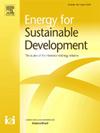Role of vernacular architecture in enhancing the environmental sustainability of the building sector
IF 4.9
2区 工程技术
Q2 ENERGY & FUELS
引用次数: 0
Abstract
Nepal's rapid urbanization, rural-to-urban transition, and economic growth have driven a major shift in building construction, moving from traditional methods using brick, stone, mud, and wood to contemporary Reinforced Cement Concrete (RCC) buildings. This transition in building construction practice raises critical questions about changes in the building life cycle energy use and emission. So, the study aimed to assess the life cycle energy consumption and carbon emissions (CO2-eq.) of the typical traditional building types in Nepal namely: attached brick houses (ABH), isolated brick houses (IBH), and isolated stone houses (ISH).
The Life Cycle Assessment (LCA) of the Nepalese traditional building shows that the life cycle energy use of traditional buildings ranges from 3573 to 5864 MJ/m2, with emissions between 438 and 681 kgCO2-eq/m2—substantially lower than RCC counterparts. A crucial factor is the use of biogenic materials in traditional buildings, which can sequester −126 to −185.5 kgCO2-eq/m2 during their lifecycle, offering a natural mechanism for reducing carbon emissions. In Nepal, where the energy mix is predominantly hydropower and residential buildings have minimal operational energy demands due to limited space heating and cooling provision, embodied carbon becomes a decisive factor in evaluating the environmental impact of construction. Traditional building practices present a compelling strategy for reducing embodied energy and emissions, thereby supporting sustainable development. The study highlights the importance of leveraging traditional building methods to create a low-carbon future, particularly in contexts like Nepal where renewable energy resources and low operational energy needs align with the advantages of biogenic materials.
乡土建筑在提高建筑行业环境可持续性方面的作用
尼泊尔快速的城市化、农村向城市的转型和经济增长推动了建筑施工的重大转变,从使用砖、石、泥和木材的传统方法转向现代钢筋水泥混凝土(RCC)建筑。建筑施工实践中的这种转变提出了关于建筑生命周期能源使用和排放变化的关键问题。因此,该研究旨在评估尼泊尔典型传统建筑类型的生命周期能耗和碳排放(CO2-eq.),即:附砖房(ABH),隔离砖房(IBH)和隔离石房(ISH)。尼泊尔传统建筑的生命周期评估(LCA)表明,传统建筑的生命周期能源使用范围为3573至5864焦耳/平方米,排放量在438至681千克二氧化碳当量/平方米之间,大大低于碾压混凝土。一个关键因素是在传统建筑中使用生物材料,在其生命周期内可以隔离- 126至- 185.5千克二氧化碳当量/平方米,为减少碳排放提供了一种自然机制。在尼泊尔,能源结构主要是水电,由于供暖和制冷空间有限,住宅建筑的运营能源需求很少,因此隐含碳成为评估建筑对环境影响的决定性因素。传统的建筑实践为减少隐含能源和排放提供了令人信服的战略,从而支持可持续发展。该研究强调了利用传统建筑方法创造低碳未来的重要性,特别是在尼泊尔这样的环境中,可再生能源资源和低运营能源需求与生物材料的优势相结合。
本文章由计算机程序翻译,如有差异,请以英文原文为准。
求助全文
约1分钟内获得全文
求助全文
来源期刊

Energy for Sustainable Development
ENERGY & FUELS-ENERGY & FUELS
CiteScore
8.10
自引率
9.10%
发文量
187
审稿时长
6-12 weeks
期刊介绍:
Published on behalf of the International Energy Initiative, Energy for Sustainable Development is the journal for decision makers, managers, consultants, policy makers, planners and researchers in both government and non-government organizations. It publishes original research and reviews about energy in developing countries, sustainable development, energy resources, technologies, policies and interactions.
 求助内容:
求助内容: 应助结果提醒方式:
应助结果提醒方式:


